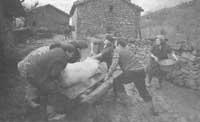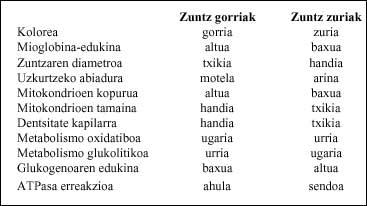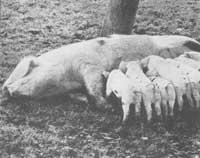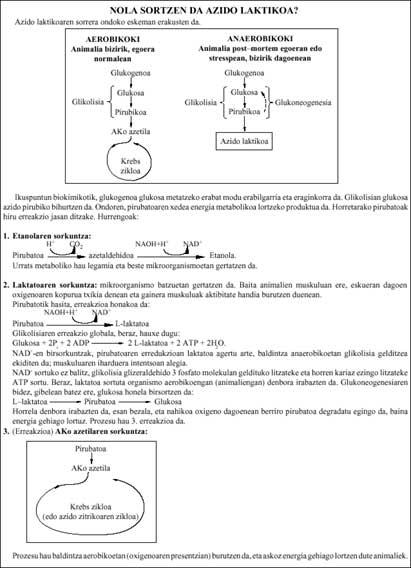Quality and pig production

First, we must differentiate the quality of pork channel from the quality of the musculature and fat that a channel provides. Both concepts do not coincide. Therefore, when it comes to classifying the quality of the channel in slaughterhouses it is done according to the muscle content (that is, more muscle and less fat, higher quality of the channel). But the more muscle and the less fat the pork channel has, the worse quality the pig has.
How has this situation come about? The basis of the problem lies in human selection. The selection process carried out by farmers among pig breeds had a specific purpose: to obtain the maximum number of pork products in the shortest possible time and with the lowest food consumption.
It can be said that selecting these animals to get the most meat from pigs is the same as choosing for the effectiveness of your growth hormone. This has increased the muscle mass of the pig, generating a disproportionate animal. These animals can be considered disproportionate. And it is that your skeletons must bear more weight and the circulatory system must supply more muscles to the blood.
Circulatory systems have not changed in size and as a result, these animals present problems of support and difficulties to move on their four legs. Their cardiac and respiratory devices are insufficient and their muscle increase leads to the appearance of white muscle fibers. These fibers show differences with respect to red muscle fibers. They condition muscle physiology and therefore limit the transformation of muscle into edible pork while pre- and post-mortem processes occur.
Here are some differences between red and white muscle fibers:

This selection has generated a neuro-hormonal imbalance in the pig and an interanimal variability among pig breeds. Therefore, at present we can differentiate two types of pork: “Stress-sensitive” (SS) and “stress-resistant” (SE).
This classification has been made by its sensitivity to the factors that may be affected by changes in the situation of the animal. These factors are: temperature, atmospheric humidity, aggressive or strange noises, fatigue, accumulation of animals, exercises or movements, tears between animals, fear, etc.
To adapt to these narrow conditions, the animal undergoes the following changes:
- Change of heart rate.
- Change in frequency and respiratory depth.
- Increased body temperature.
- Higher metabolic expenditure for a higher amount of energy.
These variables control the animal's neuro-hormonal systems. If the animal is molded, we will have the pig SE. Otherwise it would be an SS pig.

The first symptom of an SS pig is the absence of oxygen in muscle tissue, whose origin is respiratory and cardiac scarcity (heart and lungs are small in relation to muscle volume). The second reason is the highest number of white fibers (which as we know have a lower blood supply). This shortage of oxygen in muscle tissue involves the anaerobic transformation of decomposed muscle glycogen in the form of glucose, due to the neurohormonal response produced by the pig to adapt it to stressful conditions.
The anaerobic production reaction of lactic acid occurs normally after death and not when the animal is alive. Lactic acid accumulates in acidified muscle fibers.
The reduced animal circulation system transports lactic acid to the liver to convert it back into glycogen or to the heart for direct use in energy production. In the event that the aforementioned organs cannot neutralize the lactico that is occurring in stressful conditions, the animal will die by acidosis. All this is accompanied by an increase in body temperature (42-44ºC).
From the pig totally SE (firm against any stress factor) to the pig SS that dies in seconds from the acidosis at one end of the neck wedge, it must be noted that there are many variables and depending on the amount of glycogen or lactic acid that contains the musculature in the pre-mortem processes, the post-mortem process (rigor mortis and maturation of the meat) is “programmed”. Therefore, it limits the future quality of the pig.
PSE (Pale, Soft, Exudative) is a pale, soft, sweaty flesh that shows acidosis in your premature muscles. In addition, the higher the acidosis and temperature, the higher the PSE feature. The final pH in meat, 24 hours post-mortem, may be less than 5.5, but sometimes somewhat higher and with the same characteristics of PSE, if the final pH data has been measured in shorter times. The most authentic PSE cards are those with a pH whose last value reaches the musculature before an hour. Do not forget that the final pH of meat that can be considered technologically normal ranges between 5.6 and 6.
The current trend is the disappearance of SS pigs. This is possible thanks to the experiences and knowledge acquired over the years. The SS pig is determined by a subdominant genetic factor that can be detected during the life of the animal. To do this, the “halothane test” is used. Halothane is an anesthetic substance, similar to chloroform, and its most remarkable feature is that the animal sleeps smoothly when administered as anesthesia to the pig SR.

If the pig is SS, halothane produces tetany in the extremities, being able to have total stiffness, both in the branches and in the spine. This halothane test is used to select SR breeding pigs. Obtaining pork with high meat production by genetic selection. But at the same time it has been essential to feed properly to make the most of the production. Currently, feed with high content of basic amino acids and calories allow to obtain low transformation rates, that is, less than 3 kg of feed is needed to obtain 1 kg of meat.
In the field of food, some negative aspects such as growth factors such as copper and fatty feeds used to provide “cheap” calories in high protein feed can be cited. One of the growth factors excessively used in pig feeding is copper. The drawback of this element is to help the watering of pork fat. In fact, copper acts as a catalyst for oxidation and causes a greater presence of unsaturated fatty acids.
Another worrying problem appears in Urdabereta. The excess fat that is given in the feed to cover the metabolic needs of the pig accumulates in the body of the animal in the same way that has been added to the feed. Therefore, fats commonly used in pork diet have rare flavors (taste of fish, sheep, ginger…) that directly affect the taste of pork. Therefore, considering that the limiting factor of the organoleptic quality (color, smell, taste) of any meat is fat, we will immediately realize that the specific quality of the fats used in pig feed comes from the carbohydrates of the crops present in your body and in feed, mainly corn.
On the other hand, a technique widely used in pig bristle (and currently shows more problems of apica) is not to dirty pork males. Androsterone accumulates in the fat of the pig and is a hormone created in the sexual glands of the hour, being responsible for the bad smell (sometimes annoying) of the pig. This occurs when the pig supports high temperatures, well cooked, in barrel or after frying.
In short, we can affirm that the lower consumption of fresh meat and the low quality of the elaborated pork is directly related to the unspotted pork males and the grease of feed based on inadequate fat.

Buletina
Bidali zure helbide elektronikoa eta jaso asteroko buletina zure sarrera-ontzian











